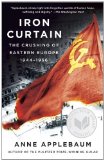Summary | Excerpt | Reviews | Beyond the Book | Readalikes | Genres & Themes | Author Bio

Critics' Opinion:
Readers' Opinion:
First Published:
Oct 2012, 608 pages
Paperback:
Aug 2013, 640 pages
 Book Reviewed by:
Book Reviewed by:
Kim Kovacs
Buy This Book
But Arendt was wrong: 'the Russian rulers' did not follow the convoluted stages of the October Revolution in Eastern Europe. They applied only those techniques which they knew had a chance of success, and they undermined only those institutions which they believed it absolutely necessary to destroy. This is why their story is so full of interest: it tells us more about the totalitarian mindset, Soviet priorities and Soviet thinking than would any study of Soviet history on its own. More importantly, a study of the region tells us more about the ways in which human beings react to the imposition of totalitarianism than would a study of any one country on its own.
In more recent years, a wide range of scholars have begun to acknowledge this. In the two decades since the collapse of communism and the opening of archives across Central Europe, Germany and Russia, an enormous amount of academic work has been devoted to the region. Particularly well covered, in the Anglophone world, are the physical and human consequences of the Second World War – notably in the work of Jan Gross, Timothy Snyder and Bradley Abrams – as well as the history of ethnic cleansing in the region. 31 The international politics of the region are even better understood. Whole institutes now devote themselves to the study of the origins of the Cold War and the US –Soviet conflict. I have mostly relied on secondary sources when discussing these subjects.
The same is true of the political history of Eastern Europe, which has been very well told using archival sources in regional languages. I have not tried to replicate the work of excellent historians such as Andrzej Paczkowski and Krystyna Kersten, whose writings on the Polish communist leadership and secret police remain unsurpassed; Norman Naimark, whose book on the Soviet occupation of East Germany is the defi nitive work in English; Peter Kenez and László Borhi, who have written superb accounts of the political machinations in Hungary; Bradley Abrams, Mary Heimann and Karel Kaplan, who have described the period in Czechoslovakia. Certain more defined topics have also been the focus of excellent articles and full-length books. Among the best, again in English, I would include John Connelly on the Stalinization of Eastern European universities; Catherine Epstein and Marci Shore on communists and left-wing intellectuals; Mária Schmidt on the show trials; Martin Mevius on national symbolism in Hungary; Mark Kramer on de- Stalinization and the events of 1956.
General histories of the region as a whole are much rarer, if only because of the logistical difficulties. It's not easy to find a historian who reads three or four of the regional languages, let alone nine or ten. Anthologies are often the answer and there are at least two very good recent ones: Stalinism Revisited: The Establishment of Communist Regimes in East-Central Europe and the Dynamic of the Soviet Bloc (New York and Budapest, 2009 ), edited by Vladimir Tismaneau, and The Establishment of Communist Regimes in Eastern Europe, 1944 – 1949 , edited by Norman Naimark and Leonid Gibianskii (Boulder, Colo., 1997 ). But though both volumes contain excellent essays, anthologies don't necessarily look for patterns or make comparisons. Since I wanted to do exactly that, I had the assistance of two superb researchers and translators, both writers in their own right, while working on this book, Regine Wosnitza in Berlin and Attila Mong in Budapest. I relied on my own knowledge of Polish and Russian.
Although much has been written about this period, there are still many, many untold stories. While preparing to write this book, I worked in former secret police archives – IPN in Warsaw, ÁBTL in Hungary, BstU (the Stasi archive) in Berlin – as well as the archives of government ministries, German art academies, the Hungarian fi lm institute, East German and Polish radio, just to name a few. I also made use of several new, or relatively new, collections of Soviet documents on the period. These include the two volumes of Vostochnaya Evropa v dokumentakh rossiskikh arkhivov, 1944 – 1953 (Eastern Europe in Documents from the Russian Archives 1944 – 1953 ), as well as the two volumes of Sovetskii faktor v vostochnoi evrope, 1944 – 1953 (The Soviet Factor in Eastern Europe 1944 – 1953 ) and a three-volume series on Soviet occupation policy in Eastern Germany, all published in Moscow with Russian editors, as well as a seven-volume series published by the Russian state archive, on the same topic. A joint commission of Polish and Ukrainian historians have now put together an imposing series of documents on their mutual history. In addition, the Polish Military Archive in Warsaw has a large collection of documents copied from Russian archives in the early 1990 s. The Central European University Press has also published two excellent document collections on the uprisings in Germany in 1953 and Hungary in 1956. A wide range of documents has been published in Polish, Hungarian and German as well.
Excerpted from Iron Curtain by Anne Applebaum. Copyright © 2012 by Anne Applebaum. Excerpted by permission of Doubleday. All rights reserved. No part of this excerpt may be reproduced or reprinted without permission in writing from the publisher.




Good as it is to inherit a library, it is better to collect one.
Click Here to find out who said this, as well as discovering other famous literary quotes!
Your guide toexceptional books
BookBrowse seeks out and recommends the best in contemporary fiction and nonfiction—books that not only engage and entertain but also deepen our understanding of ourselves and the world around us.